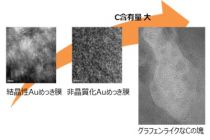Hard-gold film technology for the realization of low-resistance and high mechanical strength
2012-0712-05

- researcher's name
-
about researcher OSAKA, Tetsuya Senior Research Professor (retired)
- affiliation
-
- research field
-
Device related chemistry,Nanobioscience,Electronic materials/Electric materials
- keyword
-
background
Hard-gold film is used for electronic contact materials including USB terminals, and plays a role for the transfer of information and provision of electricity among analog and digital products. There is a need to improve electronic properties as well as chemical and mechanical qualities beyond the current levels for connection materials.
summary
This technology introduces carbon to hard AuNi film, making the structure of the film amorphous, and producing AuNiC film with greatly heightened abrasion resistance without lowering its electric resistance. A technology concerning the manufacturing of AuNiC film.
application/development
A current hard gold film surrogate and next-generation micro-connection film.
predominance
The cost of gold accounts for over 90% of the composition cost of gold coating film. The film used by this project is a thinner film with good mechanical properties, enabling effective cost cutting. In addition, it is possible to apply this technology’s high sustainment of electric transmission to fine connection materials including microscopic connectors. In addition to crystalline and amorphous gold film compositions, by increasing the amount of carbon, this same method can also create grapheme film, as shown in the diagram, and for the creation of nickel carbide film by removing the material’s auric salts.
purpose of providing seeds
Sponsord research, Collaboration research, Technical consultation
material
same researcher's seeds
-
 Field Effect Transistor Sensor
Field Effect Transistor Sensor -
 Manufacturing of nano particle array substrates
Manufacturing of nano particle array substrates -
 All Wet ULSI manufacturing process
All Wet ULSI manufacturing process -
 Evaluating lithium-ion battery (LIB) cell degradation using an impedance measurement
Evaluating lithium-ion battery (LIB) cell degradation using an impedance measurement -
 Long-life negative silicon anode synthesis for next-generation lithium-ion batteries
Long-life negative silicon anode synthesis for next-generation lithium-ion batteries -
 Production technology development for the creation of a next-generation laminated lithium-ion battery
Production technology development for the creation of a next-generation laminated lithium-ion battery -
 Monitoring Chemical Balance in Epidermal Barriers
Monitoring Chemical Balance in Epidermal Barriers -
 Development of Biosensing Technology for Food Safety
Development of Biosensing Technology for Food Safety -
 Development of magnetic nanoparticles for cancer care
Development of magnetic nanoparticles for cancer care -
 Chemical Health Monitor Kind to Skin
Chemical Health Monitor Kind to Skin -
 Seeing mental stress from invisible substances
Seeing mental stress from invisible substances -
 Battery Diagnosis by Square-Current Electrochemical Impedance Spectroscopy
Battery Diagnosis by Square-Current Electrochemical Impedance Spectroscopy
posted:
2014/05/21
